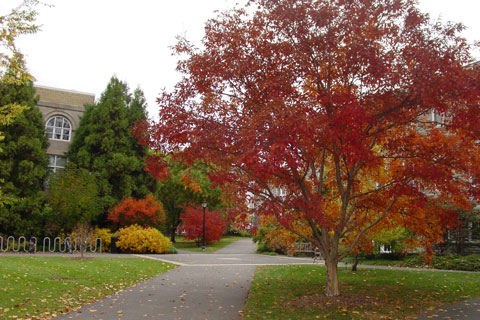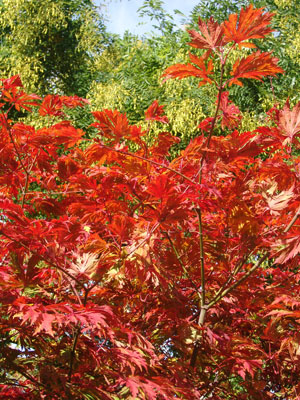3/1/2023
Small Trees For Great Fall Color
Andrew Bunting

An entire article, if not book, could be written on the many selections of just Japanese maples with fantastic fiery red to orange to bright golden fall color. There are many other maple species to choose from, as well as other types of beautiful trees that have wonderful fall color and other seasonal attributes, including great flowers, bark and sometimes even ornamental fruit.
Pictured: Acer triflorum in the foreground, with Acer pseudosieboldianum and Acer japonicum Aconitifolium in the background
Starting With Maples
There are literally hundreds of cultivars of Japanese maples. Some Japanese maples are upright trees to 30-ft. tall and others are cascading types or are diminutive in stature. Some favorites include Acer palmatum Ruysen. It’s an amazing weeping and cascading form to 20-ft. tall with small palmate leaves. Like many Japanese maples, the stunning fall color is a combination or yellow, orange and red. Some of the more traditional cascading Japanese maples, including Crimson Queen and Tamuykeyama, have purple summer foliage that’s very dissected and filigreed with blazing orange fall color. Both over time turn into a small to medium-sized cascading and very architectural trees.
Closely related is the full moon maple, Acer shirasawanum. Each leaf has seven to nine pointed leaves. Autumn Moon is a selection with a suffusion of pink, orange and yellow in the summer. The best coloration occurs in partial to dappled shade, and in the fall the color becomes more golden. At maturity, it reaches 12-ft. tall with a spread of 6 ft. Another close relative is Acer japonicum Aconitifolium. This small tree reaches 10- to 12-ft. tall with amazing fire-engine red fall color.
The Korean maple, Acer pseudo-sieboldianum, is a small tree gaining in popularity. Northern Spotlight is a selection by North Dakota State University that can tolerate USDA Zones 3 to 4 and -30 to -40F. At maturity, it reaches 13-ft. tall with a spread of 10 ft. In the fall, it turns to a stunning orange-red.
Iseli Nursery has introduced the trademarked Jack Frost maple collection that includes North Wind, which is hardy to Zone 4 and has orange to scarlet fall color. It’s a hybrid between Acer palmatum and Acer pseudosieboldianum.
First Flame in the spring has a blend of yellow, pink and green, and in the autumn transforms to orange, red and finally brilliant red.
The paperbark maple, Acer griseum, is simply one of the best-of-the best trees. Throughout the season it has vibrant cinnamon-colored peeling bark. At maturity, it can reach 25-ft. tall with an equal spread, but is relatively slow growing. In the fall, the autumn color is akin to the sugar maples with a blend of yellow, orange and red. A close relative is the three-flowered maple, Acer triflorum, which primarily differs in that the bark is a beige to tawny color.
Smaller Fruiting & Flowering Trees
A popular native tree with large tropical-like leaves and golden fall color is the paw paw, Asimina triloba. It’s also sometimes referred to as the Michigan banana or Indiana banana because it’s found colonizing the understory of woodlands throughout the east and midwestern states. The oblong fruit has been described as “banana-like” in its taste. As the popularity for backyard fruit trees has grown, so has the popularity of the paw paw. There are now many cultivars available and it’s important to grow more than one at a time to ensure cross-pollination and therefore good fruit set.
 Pictured: A close-up of Acer japonicum Aconitifolium, which grows to about 10- to 12-ft. tall.
Pictured: A close-up of Acer japonicum Aconitifolium, which grows to about 10- to 12-ft. tall.
The flowering dogwood, Cornus florida, has multiple seasons of interest, including an abundance of four-petaled white or pink flowers in late spring and beautiful red to purple fall color. This native is also a great food source of birds with its abundance of red fruits. Appalachian Spring has white flowers and Appalachian Sunrise has an abundance of pink flowers. Both were developed through the University of Tennessee breeding program and are noted for the resistance to Dogwood Anthracnose.
More Flowering Trees
The Franklin tree, Franklinia alatamaha, was popularized by the early botanists John and William Bartram when they discovered this rarity on a collecting trip to Georgia. This multi-stemmed tree that can ultimately reach 30-ft. tall is covered in white, camellia-like flowers with a boss of golden anthers in August. As the tree matures, the gray trunks develop white striations. In the fall, the strap-like leaves turn blazing red.
The Franklin tree can be a little finicky in the garden, however, there’s a new, more robust version, which is a hybrid between Franklinia alatamaha and Gordonia lasianthus. The resulting hybrid is a tree with most of the same attributes, but with more vigor. Sweet Tea is a selection that was made. In the southern states, the tree will be mostly evergreen, but in Zone 6 it tends to have good fall color and is mostly deciduous.
The American hornbeam or musclewood is a great native tree that’s been gaining in popularity due to its adaptability and durability in the landscape. It’s tolerant of a number of urban conditions, including poorly drained soils. The species turns shades of yellow and golden in the fall. New selections include trademarked options like Palisade, which has yellow fall color and an upright, spire-like habit; Fire King, which can be grown as a single-trunked or multi-stemmed tree to 20 ft. and has reddish fall color; and Rising Fire, which is 30-ft. tall and 15-ft. wide with striking red to orange fall color.
These are just a handful of the many great small ornamental trees with great fall color. Local garden centers and nurseries will offer many of these and undoubtedly many more! GP
Andrew Bunting is the Vice President of Public Horticulture for the Pennsylvania Horticultural Society, which uses horticulture to advance the health and well-being of the Greater Philadelphia region. Andrew has decades of horticultural experience, ranging from his tenures at public gardens in the U.S. and abroad, as well as a published author, gardening expert and sought-after presenter. To learn more about PHS, or to become a member and support greening initiatives in over 250 neighborhoods, visit PHSonline.org.